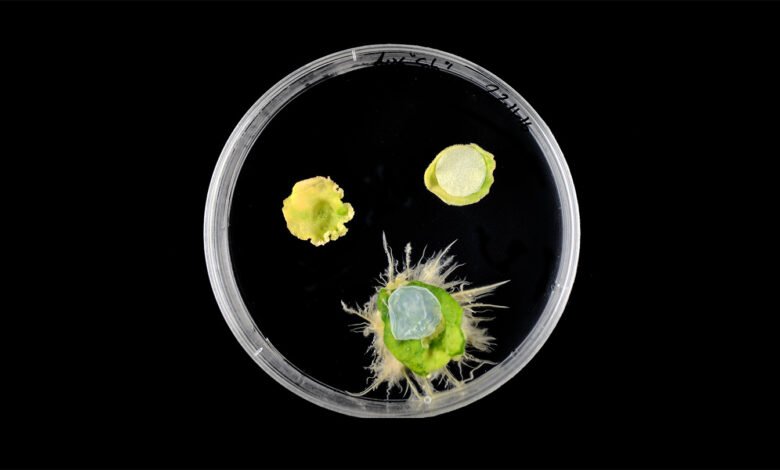لصقة بكتيرية مبتكرة تعزز شفاء النباتات من جروحها!

هل لديك نبات يعاني من جرح؟ جرب لصقة نباتية.
تشير الأبحاث إلى أن شكلًا نقيًا من السليلوز ينتجه البكتيريا يمكن أن يعمل كضمادة للنباتات، مما يعزز بشكل كبير الشفاء والتجديد في النباتات. وقد تم وصف هذا الاكتشاف في 12 فبراير في مجلة Science Advances، وله آثار محتملة على الزراعة وبحوث النباتات.
على عكس الحيوانات، لا يمكن للنباتات الهروب من الخطر وتعتمد بدلاً من ذلك على قدراتها التجديدية الرائعة. وقد وُجد أن السليلوز البكتيري – الذي يُستخدم بالفعل في الطب البشري لعلاج الجروح والحروق بسبب توافقه الحيوي وقابليته للتحلل والاحتفاظ العالي بالماء – يعزز أيضًا شفاء النباتات.
كانت عالمة الأحياء النباتية نيريا سانشيز كول وزملاؤها يختبرون لصقات السليلوز البكتيري المدمجة بجزيئات الفضة لمنع العدوى في النباتات المصابة. وسرعان ما لاحظوا أن الجروح المعالجة باللصقات شفيت بشكل أفضل وأسرع. تقول سانشيز كول، من مركز أبحاث الجينوم الزراعي في برشلونة، “هذا جعلنا مهتمين بالبحث عن السبب الجزيئي لهذه العملية”.
لاختبار فعالية اللصقات كأجهزة للشفاء، قام العلماء بعمل قطع صغيرة في أوراق نوعين شائعين من نباتات المختبر، Nicotiana benthamiana وArabidopsis thaliana. وتم تطبيق “اللصقات” على نصف الجروح فقط. بعد أسبوع واحد، كانت أكثر من 80% من الجروح المعالجة قد شفيت تمامًا مقارنة بأقل من 20% للجروح غير المعالجة. أظهرت التحليلات المجهرية أن الأنسجة في الجروح المعالجة بدت صحية بينما أظهرت الجروح غير المعالجة علامات الضيق والجفاف.
كما اكتشف الفريق أن اللصقات تعزز تجديد النبات بشكل كبير، خاصةً في تجارب الاستنساخ. العديد من النباتات تتكاثر لاجنسيًا عبر التكاثر الخضري وهو عملية تُستخدم في البحث والزراعة لزراعة نبات جديد مطابق وراثيًا قطعةً واحدةً فقط منها أخرى. عندما تمت إضافة لصقات السليلوز البكتيري إلى قصاصات داخل أطباق بتري، كانت النباتات تتجدد بسرعة أكبر وتطور جذوراً وأوراقاً أسرع مقارنة بالقصاصات غير المعالجة. ومن المثير للاهتمام أنه لم يكن للصاقات المصنوعة من سليلوز النبات نفس التأثير.
A revealed chemical analysis revealed that the bacterial cellulose contained plant hormones, probably produced by the bacteria responsible for its synthesis.
Bacteria have coevolved with plants for millions of years, producing hormones that influence plant behavior for the bacteria’s benefit.
The researchers were surprised that these hormones remained intact despite previous sterilization of the patches to avoid contamination.
“We think that the cellulose matrix is so dense that it preserves the hormones, which remain bioactive,” Sánchez Coll says.
A genetic level, bacterial cellulose–induced healing appears distinct from normal plant wound repair.
The bacterial cellulose triggered a different set of genes, turning off some typically involved with healing while activating others related to infection defense.
The researchers believe this altered response results from a combination of factors:
The wound itself,
The presence of bacterial hormones and
The plant’s reaction to the bacterial cellulose as a foreign body,
Potentially triggering a defensive mechanism.
Although bacterial cellulose has been widely used in human medicine, this is the first time it has been found to have intrinsic biological activity. says Anna Roig, a materials scientist at the Institute of Materials Science of Barcelona who wasn’t involved in the study. Plant scientist Javier Agustí also not involved in study sees enormous biotechnological potential. “I would be very interested in seeing how well it works in real crops,” says Agustí, of Institute for Plant Molecular and Cellular Biology Plants Valencia Spain, While still early stages findings do suggest potential applications agriculture Sánchez Coll says such as facilitating grafting preserving cut plant material or serving growth medium laboratories Other research groups already looking these findings molecular level trying determine if they apply other regeneration processes aren’t yet fully understood.




